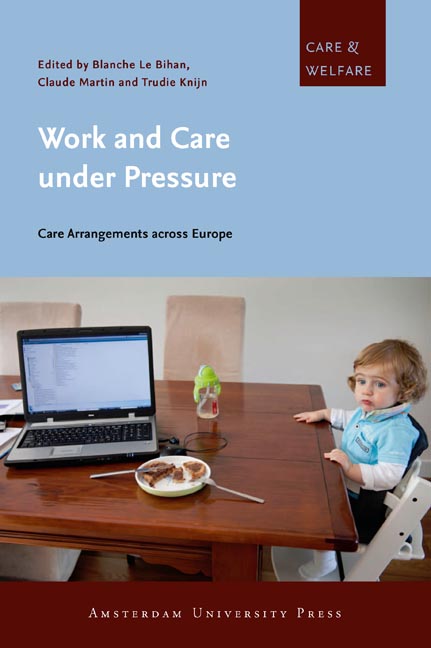Book contents
- Frontmatter
- Contents
- 1 Introduction: Workers under pressure and Social care Arrangements: A Research Framework
- 2 Work-family Balance in the Netherlands: Work and Care Culture Mediating Between Institutions and Practices
- 3 Negotiating Gender Equality, Atypical Work Hours and Caring Responsibilities: The case of Sweden
- 4 Caregiving and Paid work in Germany: The Impact of Social Inequality
- 5 Working Caregivers ‘Living Under Pressure’ in France
- 6 Negotiating Work and care in a Changing Welfare Regime: The case of Portugal
- 7 Blurring Boundaries and Clashing Loyalties: Working and caring in Italy
- 8 The changing mix of care in six European Countries
- About the Contributors
- Care & Welfare
7 - Blurring Boundaries and Clashing Loyalties: Working and caring in Italy
Published online by Cambridge University Press: 06 January 2021
- Frontmatter
- Contents
- 1 Introduction: Workers under pressure and Social care Arrangements: A Research Framework
- 2 Work-family Balance in the Netherlands: Work and Care Culture Mediating Between Institutions and Practices
- 3 Negotiating Gender Equality, Atypical Work Hours and Caring Responsibilities: The case of Sweden
- 4 Caregiving and Paid work in Germany: The Impact of Social Inequality
- 5 Working Caregivers ‘Living Under Pressure’ in France
- 6 Negotiating Work and care in a Changing Welfare Regime: The case of Portugal
- 7 Blurring Boundaries and Clashing Loyalties: Working and caring in Italy
- 8 The changing mix of care in six European Countries
- About the Contributors
- Care & Welfare
Summary
Introduction
This chapter focuses on the impact of combining care and work on couples with small children and on children who take care of older parents in Italy. This requires a consideration of the ways in which family, work and private and social life are affected by this experience. But it also highlights the fact that, in a context of a highly familialised care system like Italy’s, solutions to reduce the pressures on parents who work (with atypical jobs or working hours) are provided by generations who are soon likely to be in need of care themselves, while at the same time a ‘middle’ generation, still employed in paid work, must split its care between young families with working mothers and frail elderly persons.
Our analysis of the work and care balance in Italy therefore focuses on the family, and primarily on the family relationship – that is, the family kinship network and in particular generational relationships in different phases of the life course. We first consider how new work-family balances are based on and shaped by the different forms of generational dependencies and interdependencies. We then look at how the exchange and support of family care, but especially generational exchange and (inter) dependencies, contribute to blurring the boundaries not only between different types of care (formal and informal) but also among different households. From an analytical point of view, two concepts of the family are employed: the first refers to the relationship between family members, regardless of who lives with whom; the second refers to the household – that is, who lives with whom.
Two main questions are raised in comparing the similarities and differences in work-care balancing for children and the elderly. How do intergenerational work-care strategies contribute to blurring the boundaries between households? And how do intergenerational work-care arrangements create tensions among different loyalties, as well as between family membership and individual aspirations and choices?
The policy context and the central role of intergenerational ties
In Italy, notwithstanding increasing female labour-market participation and population ageing, the ‘strong family ties’ model (Reher 1998) continues to be perceived in the public discourse and in policies as the inexhaustible resource to be tapped when life-course transitions or unexpected crises render an individual or a household vulnerable.
- Type
- Chapter
- Information
- Work and Care under PressureCare Arrangements across Europe, pp. 151 - 170Publisher: Amsterdam University PressPrint publication year: 2013



